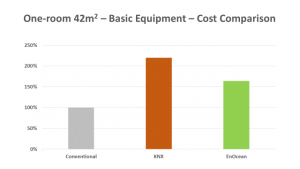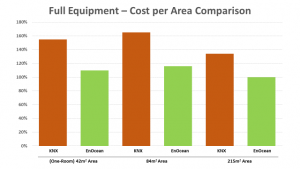Wired or Wireless: Which is Better Suited for a Networked Building?
By Graham Martin, Chairman & CEO EnOcean Alliance and Marketa Sidlikova M.Sc. Fin.
Intelligent working environments with needs-based regulation of temperature, air quality and lighting can have a positive effect on the comfort and well-being of employees, increasing their motivation and productivity. What large companies do in their Smart Spaces is now becoming increasingly easier to do on a small scale. The leverage here is the use of existing smart building functionalities. The hardware alone however does not make a building intelligent. It depends on the type of networking: wired or wireless? A new study by the Technical University of Applied Sciences Rosenheim compares the common standards KNX and EnOcean in different scenarios and the results applied to intelligent commercial spaces.
Employees who feel good work better, are healthier and more productive. Larger companies in particular have understood this important connection. They rely on intelligent office space – so-called smart spaces – and sensor-based infrastructure management. These collect sensor-generated building condition data and uses it for adjustments or analyses. This allows important factors influencing employee productivity and office hygiene – temperature, air quality, lighting conditions and cleanliness – to be monitored and controlled according to the number of people in the building and the ambient conditions. Smart Spaces form an interface between people and their work environment. They complement the physical workspace with a virtual component – with positive effects on the well-being and productivity of the employees.
What is increasingly being implemented on a large scale can also be implemented on a small scale. For the first steps towards intelligent buildings, SMEs can use smart building functionalities that are easy to install or retrofit and thus upgrade commercial spaces, offices or practices.
Different Standards
Digital networking is the prerequisite for intelligent buildings as it is what enables the individual products to communicate smoothly. This can be done in two different ways, with or without wireless technology. In addition to proprietary solutions from individual manufacturers, there are also open standards for both variants: KNX (wired) and EnOcean (wireless) are each representative in their segment.
KNX (Konnex) is a widely used wired bus system for building automation. As a further development of the EIB (European Installation Bus), KNX is an open, manufacturer-independent standard that is supported by a large number of manufacturers. As a standardized standard, KNX leaves a lot of scope for design and is considered to be particularly secure.
EnOcean was defined in March 2012 by the International Electrotechnical Commission (IEC) as a global wireless standard (ISO / IEC 14543-3-10) for decentralized building automation. In the meantime, more than a million buildings have such radio networks. The EnOcean ecosystem of self-powered wireless sensor solutions currently consists of 5,000 product variants based on 1,500 basic products. The products can be combined with one another using standardized interoperable sensor profiles.
Wired or Wireless in the Intelligent Building?
The study[1] by Julia Winkler (B.Eng.) and Prof. Dr. Michael Kroedel compares intelligent areas of different sizes based on KNX or EnOcean technology in two equipment variants with regard to costs, sustainability, health and well-being. In both cases, a conventional building without intelligent networking serves as a reference guide.
In detail the study evaluates:
- A one-room area with 42.3 m2 and a total of 33 or 42 products (basic or full equipment)
- A medium area with 83.5 m2 and a total of 70 or 89 products
- A large area of 215.2 m2 and a total of 162 or 186 products
The equipment in conventional buildings is based on the international standard DIN 18015-RAL-RG678 for the installation of electrical systems in (residential) buildings (three-star comfort equipment). The differentiation of the smart building variants is based on previous internal university research results. The basic equipment includes typical entry-level functions for comfort, safety and energy-saving. In addition to the basics, further lighting, heating and security functions are included in the full equipment versions.
The cost calculation for the individual equipment options is based on a standardized calculation aid for electrical and information technology trades (status 2020) as well as the current publically available product catalogues from representative providers such as Hager (for KNX) and Eltako (for EnOcean).
Smart Costs – Wireless is Lower Cost in Comparison
A comparison of the conventional installation with the smart equipment reveals an unsurprising picture: Smart costs initially more. According to the study, the surcharge for the electrical installation is between 64% in the one-room area with basic equipment based on EnOcean and 385% in the medium area based on KNX[2].

When comparing the smart building variants “wired” (KNX) or “wireless” (EnOcean), wireless is significantly lower in costs. With comparable functionality, the difference is 20 to 30 percent. This applies to all buildings and equipment variants in the study. This is due to the higher expense of cabling and the cost of the wired devices and their installation.

In contrast, maintenance-free wireless sensors require neither mains power nor batteries. Thanks to energy harvesting technology, they collect their energy from the environment (kinetic energy, light, or temperature differences). Wireless sensors can be simply placed wherever they are needed. This saves time and money during installation and operation and at the same time enables quick and easy retrofitting in existing buildings.
What about Electro-Smog in Wireless Smart Buildings?
The radiation exposure is 700 times lower than that of WLAN or Bluetooth connections and 1.6 million times lower than conventional smartphones. The so-called SAR (Specific Absorption Rate) is the decisive here, indicating the maximum amount of transmission power the human body can absorb.
Conclusion
The intelligently networked area initially costs more. But these investments are well worthwhile in the medium and long term for SMEs in terms of increased comfort and well-being as well as lower energy costs. The installation costs of the wireless smart spaces are up to one-third less than the equivalent wired version. They also score points in terms of flexibility and environmental protection.
[1] Winkler, J. (2021). Comparison between KNX and EnOcean using the example of room automation installations with regard to costs and ecological aspects as well as taking into account a user-oriented requirement profile. (Bachelor thesis). Technical University of Rosenheim, Germany.
[2] Overall, it should be noted that with KNX in all variants, in addition to material and installation, there are also costs for ETS (engineering tool software) and license fees.



 English
English  Deutsch
Deutsch  简体中文
简体中文  Français
Français  日本語
日本語 
